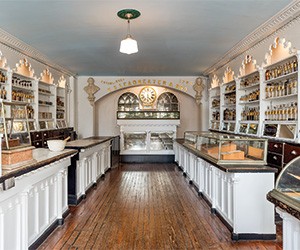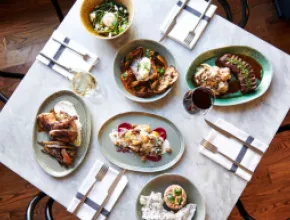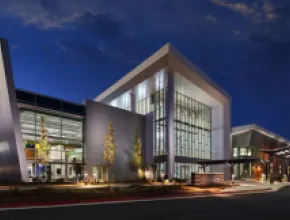In April 1607, the landing of colonizers from the Virginia Company of London at Cape Henry, now Virginia Beach, and their subsequent up-river leg to Jamestown Island set in motion events that would culminate 169 years later in the birth of the United States of America via the Declaration of Independence—principally authored by a Virginian, Thomas Jefferson.
Built on the bedrock of this singular legacy, Virginia is made to measure for today’s meetings marketplace, in which the taste for authentic experiences is having cross-generational impact across the industry.
From Colonial Williamsburg to Appomattox Court House National Historical Park, where in April 1865, generals Robert E. Lee and U. S. Grant came to the “Gentlemen’s Agreement” that ended the Civil War, the Old Dominion State abounds with American originality and inspiration, as these following standouts reveal.
Virginia Air & Space Center, Hampton
In 1917, just 14 years after the Wright Brothers first took flight, The National Advisory Committee for Aeronautics established the Langley Aeronautical Laboratory in Hampton to advance human aviation. In 1958, the same committee created the National Aeronautics and Space Administration (NASA), with the renamed Langley Research Center adding space exploration to its charter.
That same year, NASA announced Project Mercury, the five-year program to prove that manned spaceflight was possible, followed by the 1959 introduction of its first astronaut class, the Mercury Seven. This legendary group, which included John Glenn Jr. and Alan Shepard Jr., the first American to fly in space, trained in Hampton.
Serving as the visitor center for NASA Langley Research Center and Langley Air Force Base, this stellar museum exhibits these and other milestone moments in American air and space history, including the Mercury and Gemini test capsules, and the original Apollo 12 Command Module. The latter serves as a dramatic backdrop for events, with other versatile spaces that include the outdoor Observation Deck, for up to 500 people. Guests can also ride an antique carousel in adjacent Carousel Park.
National Museum of the Marine Corps, Triangle
Also in 1917, Quantico, Va., a strategic crossroads for centuries, became home base for the United States Marines Corps, which was founded in November 1775. Opened 10 years ago next month on a 135-acre site adjacent to the base, this free-admission museum is an eminently inspiring venue for group programs.
Set for completion in stages over the next four years, work is well underway on the 117,000-square-foot “Final Phase” of development, which will double the current size of the museum and make it the centerpiece of the multivenue Marine Corps Heritage Center.
Five environments for co-sponsored corporate and social events include the Tun Tavern, named for the Philadelphia tavern where the first Marines were recruited in 1775, and the Leatherneck Gallery. Set beneath the museum’s soaring Iwo Jima-inspired mast and glass atrium, this stirring space can accommodate 1,000 guests for standing receptions.
The Valentine, Richmond
In 1870, with his wife Maria gravely ill, Mann S. Valentine Jr. concocted a tonic from pure beef juice. She recovered, and Valentine’s Meat-Juice, featured at the 1878 Paris World Exposition, made Valentine a fortune.
Before his death in 1893, Valentine, an inveterate collector, bequeathed his art and antiquities, along with the landmark 1812 Wickham House, to establish the Valentine Richmond History Center.
Relaunched as The Valentine in October 2014 after a multimillion-dollar renovation, the museum’s collection is a peerless record of four centuries of Richmond life and history.
Highlights include a 40,000-piece collection of textiles and costumes; a million-plus photographic images of the city; 25,000 decorative arts pieces; and the display cabinet of Valentine’s Meat-Juice.
With programs such as several hundred guided walking and bus tours, The Valentine, located in downtown Richmond, rents elegant event spaces such as the Garden, accommodating 150 people, and the outdoor Gray Family Terrace, featuring vintage neon signs from Richmond businesses.
Stabler-Leadbeater Apothecary Museum, Alexandria
Tonics, potions and elixirs, along with herbal botanicals, hand-blown glass, medical equipment and archival materials, are also among the draws at this Alexandria institution, founded in 1792 by Edward Stabler for the manufacturing, retailing and wholesaling of a diverse line of apothecary goods.
With famous clients that have included Martha Washington and Robert E. Lee, the apothecary, which ran in this location from 1805 until 1933, supplied nearly 500 D.C.-area pharmacies at its peak.
Opened as a museum in 1939, and then donated to the City of Alexandria in 2006, the venue offers a fascinating look at early pharmacy practice via tours and specialized programs that groups can experience.
The venue offers a diverse variety of rental options, including spaces on the second floor, which range from seated meetings for between 15 and 24 participants to standing cocktail receptions for 50 people.
Nauticus, Norfolk
With a rich history that includes hosting Virginia’s only World’s Fair, the 1907 Jamestown Exposition, waterfront Norfolk is home to tour-capable Naval Station Norfolk, the world’s largest naval base, and this contemporary museum on the Elizabeth River.
PageBreak
Created jointly by the Nauticus Foundation and the City of Norfolk, the multivenue Nauticus presents diverse interactive experiences that celebrate Norfolk’s maritime past and present. These include the Battleship Wisconsin, recipient of five battle stars in World War II and available for self-guided and guided top-deck and interior tours, events and overnight stays.
Multiple versatile venues within Nauticus itself include the third-floor Power of the Sea Galleries, hosting up to 800 people for standing receptions, and on the second floor, the U.S. Navy-operated Hampton Roads Naval Museum. Scenic space at the adjacent Half Moone Cruise & Celebration Center includes the Grand Rotunda and outdoor Promenade Deck.
George Washington’s Mount Vernon, Mount Vernon
Encompassing nearly 500 acres of preserved historic property along the Potomac River, the home of America’s original presidential couple is the most visited historic estate in the nation. Open year-round, this Fairfax County and American treasure is a requisite for groups, with programs for every agenda. These include private evening mansion tours, the wreath laying ceremony at George and Martha’s tombs, and exploration of the interactive galleries and theaters within the acclaimed Donald W. Reynolds Museum and Education Center.
Planners and participants have a prestigious address for events and meetings, too, with options including the 200-seat Robert H. & Clarice Smith Auditorium, the Mount Vernon Inn restaurant for dining and receptions, and the East Lawn for outdoor gatherings of up to 1,200 people. Groups can also hold intimate events at the fully functioning reconstructions of Washington’s nearby Distillery and Gristmill.
Battlefield Park, Chesapeake
Chesapeake played its own pivotal part in the founding of the United States of America. Settled in 1620, this historic center was the site of two epic conflicts in 1775, the Battle at Kemps Landing and Battle of Great Bridge.
Lasting only 30 minutes after 11 days of skirmishes, the latter saw Patriot volunteers triumph over their professional British counterparts in the first land victory of the Revolutionary War. Denying the British access to the Norfolk seaport, the win also inspired the Virginia Convention to adopt the first public declaration expressing a spirit of independence just four days later. The result was the removal of British government from colonial Virginia—a key step forward toward July 4, 1776.
Created in tribute to these events, Battlefield Park offers docent-led tours by appointment, and on the first weekend of each December, reenactments of the two battles. Plans have been put forward, with a capital campaign underway for a visitor center and museum with amenities including space for social and civic events.
Bluemont Vineyard, Bluemont
Home to some 285 wineries, Virginia has taken root as one of the nation’s top five grape and wine producers. Stretching west of the Northern Virginia and D.C. area, scenic Loudoun County offers some 40 wineries and tasting rooms, including this event-capable draw about 17 miles north of group favorite the Salamander Resort & Spa in Middleburg.
Set on 100 acres, the family-owned vineyard sweeps up nearly 1,000 feet, leading to its hilltop tasting room and event facility with stunning panoramic views from the outdoor patio. Approaching its 10th anniversary in 2017, Bluemont hosts weddings and private parties, as well as tastings for groups ranging in size from seven to 100 guests. At the bottom of the hill, the family’s Dirt Farm Brewing has a taproom for beer tastings, while its Great Country Farms is for festivals, pick-your-own fruits and vegetables, as well as corporate meetings and events.







